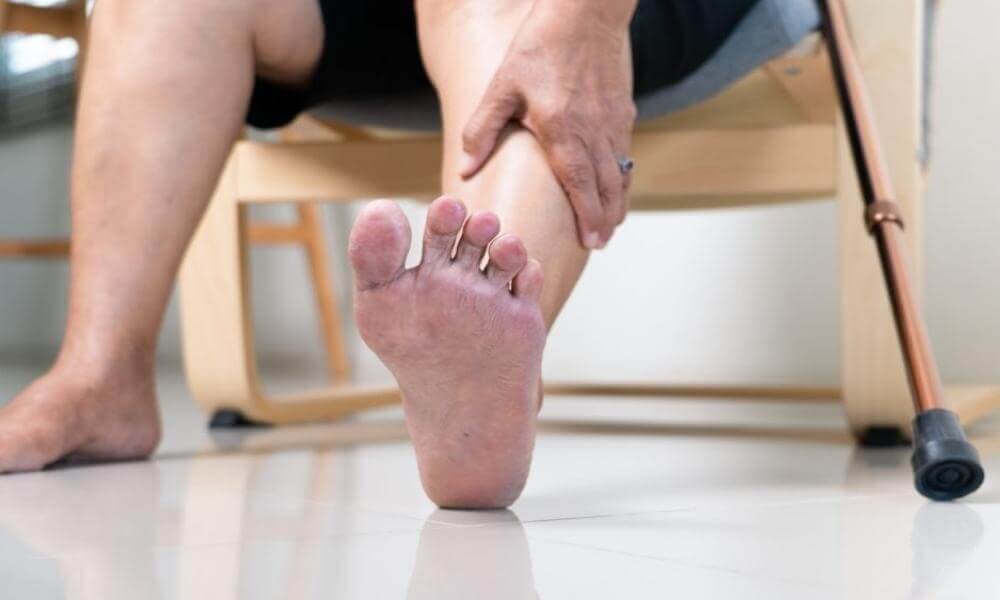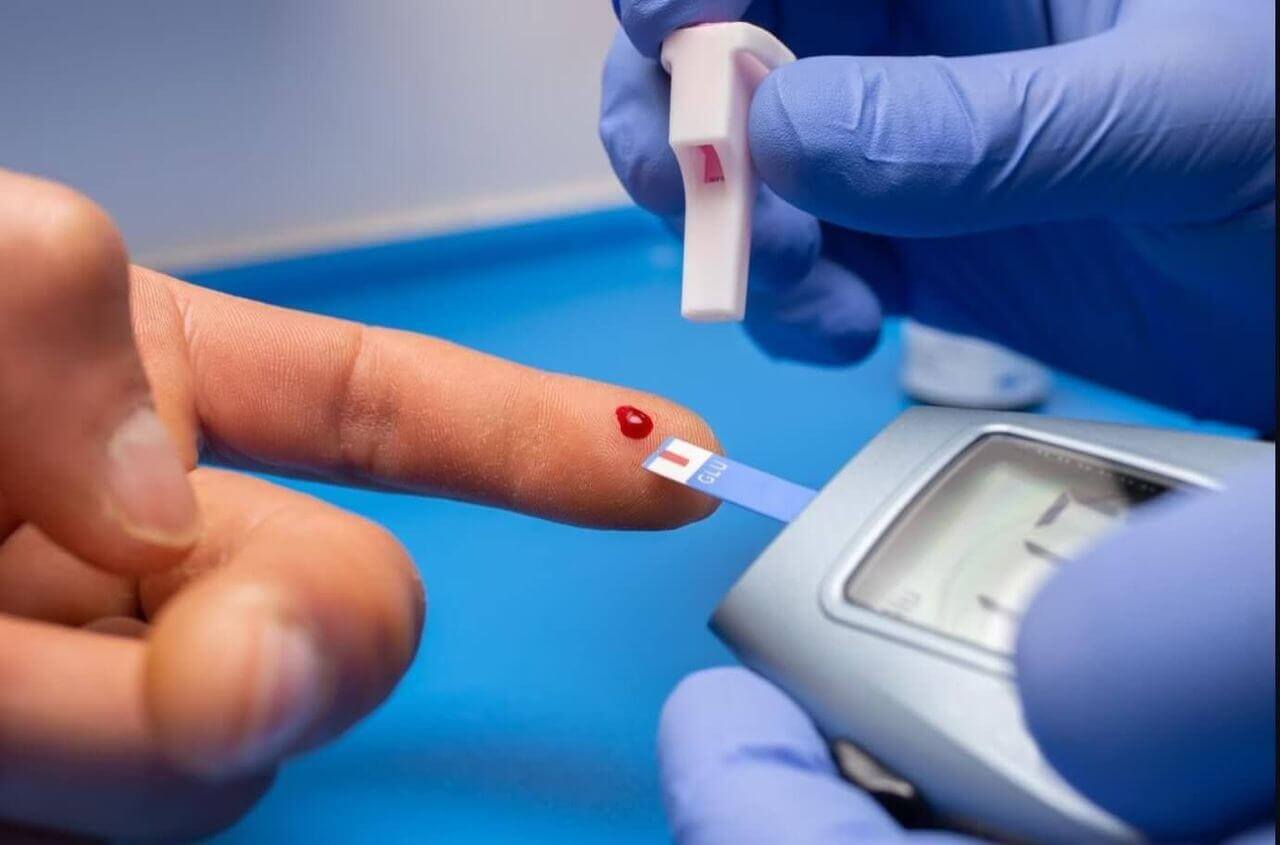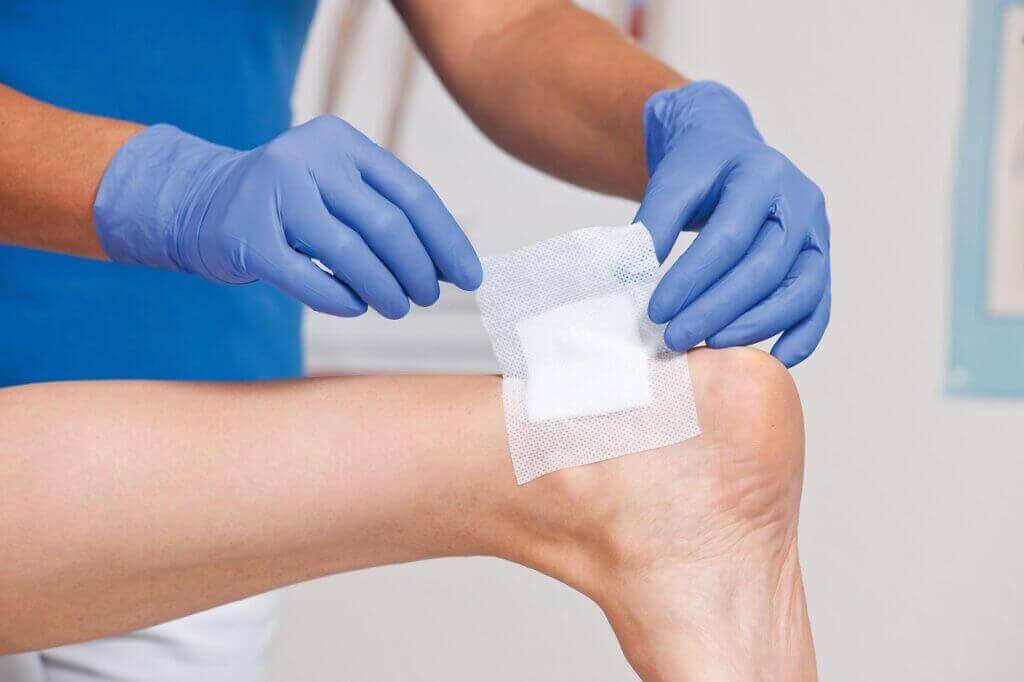
Article reviewed by: Dr. Sturz Ciprian, Dr. Tîlvescu Cătălin and Dr. Alina Vasile
Diabetic Foot - What It Is, Causes, Symptoms, and Treatment
- What is diabetic foot?
- What causes diabetic foot?
- What are the symptoms of diabetic foot?
- How does diabetic foot manifest?
- What are the predispositions/risk factors for diabetic foot?
- How is diabetic foot diagnosed?
- What are the treatments for diabetic foot?
- Complications that can occur with diabetic foot
- Methods of prevention for diabetic foot?
What is diabetic foot?
Diabetic foot is a serious complication of diabetes, characterized by injuries and infections in the feet. Diabetes can affect the nerves, reducing sensitivity to pain and injuries, so a person with diabetes may not feel a minor wound. Additionally, diabetes affects blood circulation, slowing down the healing process.
For example, a small blister caused by ill-fitting shoes may go unnoticed, and due to poor circulation, it heals slowly. Bacteria can infect the wound, leading to ulcers or even gangrene, where tissue dies due to lack of blood.
Every 30 seconds, a person undergoes an amputation of the foot due to complications of diabetes. According to specialists, diabetic foot problems are the most common cause of hospitalization for patients with diabetes mellitus, and also one of the main causes of lower limb amputation. Because circulation to the lower limbs is poor, less oxygen reaches these areas. Without it, the healing of infections and ulcers is hindered.
What causes diabetic foot?
Diabetic foot occurs when diabetes affects the feet through two main mechanisms: diabetic neuropathy and poor blood circulation.
- Diabetic neuropathy: This is nerve damage caused by high blood sugar levels. When the nerves are affected, sensations in the feet, such as pain, temperature, or touch, diminish or disappear. Because of this, a person with diabetes may not feel a cut, blister, or other minor foot injury.
- Poor blood circulation: Diabetes can also affect blood vessels, especially the small ones in the feet, reducing blood flow. Poor circulation means that the feet do not receive enough oxygen and nutrients necessary for wound healing. As a result, a small wound may heal very slowly or not at all.
The combination of diabetic neuropathy and poor blood circulation makes minor wounds go unnoticed and heal slowly. These wounds can easily become infected. If the infection is not treated in time, it can spread and lead to severe ulcers or even gangrene, which is the death of tissue.
What are the symptoms of diabetic foot?
The main symptoms of diabetic foot are signs that patients directly experience and can range from mild to severe. These symptoms indicate that complications may arise and require special attention to prevent more serious problems. Patients with diabetes should be aware of the following symptoms:
- Loss of sensation is one of the first signs of diabetic foot. This occurs due to diabetic neuropathy, which affects the peripheral nerves. People with this condition may feel numbness or tingling in their feet and toes. For example, you might walk barefoot and step on a sharp object without immediately feeling the pain. This is dangerous because wounds can go unnoticed and untreated, leading to serious complications.
- Pain: Although diabetes can reduce the sensation of pain, some patients experience significant discomfort. This pain can range from mild to severe and often occurs at night, disrupting sleep. The pain can be described as burning, stinging, or a feeling of electric shock. It can be constant or intermittent, and is often difficult to manage without medical help. The patient may feel numbness, tingling, or have a reduced ability to sense pain or temperature changes in the feet.
- Dry and cracked skin is a common problem in people with diabetes. This can occur because the nerves that control the sweat glands are affected, and the feet no longer sweat normally. The skin becomes dry, brittle, and can crack easily, especially in areas of high pressure such as the heels. Cracks can be deep and painful, and if not treated, can lead to infections.
- Changes in skin color are a visible indicator of circulatory problems. The skin may become pale, blue, or red. Pale or blue skin indicates poor blood circulation, meaning that the tissues are not receiving enough oxygen and nutrients. Red skin may indicate inflammation or a localized infection. These color changes are clear signs that the foot is not receiving proper care and requires immediate medical evaluation.
Symptoms of diabetic foot can vary from person to person. Sometimes, patients may have serious complications even in the absence of obvious symptoms. Therefore, it is important for people with diabetes to
regularly inspect their feet and pay close attention to the presence of wounds or inflammation. Since the immune system of people with diabetes is weakened, they are prone to infections, as glucose promotes the
multiplication of microbes. Therefore, a foot infection has a higher risk of complications.

How does diabetic foot manifest?
Manifestations are the objective and visible signs of the disease, which can be observed by both the patient and the doctor. These include physical and structural changes in the feet. Manifestations of diabetic foot include:
- Wounds and ulcers that do not heal: Open injuries, such as ulcers, are common and heal very slowly due to poor circulation and impaired immunity.
- Persistent infections: The feet may develop severe infections, manifested by redness, swelling, and purulent discharge, which are difficult to treat and may require emergency medical interventions.
- Structural changes in the foot: Deformations, such as hammer toes or abnormal alignments of the toes, may occur due to muscle imbalances and abnormal pressure on certain areas. (The so-called Charcot diabetic foot, with degenerative joint deformities as a late complication of diabetes, is now seen almost exclusively in diabetic patients.)
- Thin and fragile skin: The skin becomes very thin and fragile, prone to tears and injuries.
- Gangrene: In severe cases, lack of circulation and infections can lead to tissue death, known as gangrene, which may require amputation.
- Calluses and corns: Constant friction and pressure on certain areas lead to the formation of calluses and corns.
What are the predispositions/risk factors for diabetic foot?
Diabetic foot can affect anyone with diabetes, but certain conditions and behaviors increase the risk of developing this complication. Here are the main risk factors:
- Poor glycemic control: Individuals who do not manage their blood sugar levels well are more prone to nerve and vascular complications.
- Peripheral neuropathy: Damage to peripheral nerves due to diabetes can lead to loss of sensation in the feet, increasing the risk of unnoticed wounds and ulcers.
- Duration of diabetes: The longer a person lives with diabetes, the higher the risk of developing neuropathy and circulatory problems.
- Smoking: Smoking affects blood circulation and can exacerbate diabetes complications, including diabetic foot.
- Peripheral artery disease: Poor blood circulation in the feet due to narrowed or blocked arteries increases the risk of ulcers and infections.
- Obesity: Excess body weight can put additional pressure on the feet, increasing the risk of wounds and ulcers.
- Foot hygiene: Inadequate foot care, including neglecting cuts and blisters, can increase the risk of infections and complications.
- Improper footwear: Wearing shoes that do not fit properly or cause friction can lead to wounds and blisters, which are dangerous for people with diabetes.
- High blood pressure: High blood pressure can affect circulation and vascular health, worsening the risk of foot problems.
- Age: Older individuals have a higher risk of developing diabetes-related complications, including diabetic foot.
- History of ulcers or amputations: Individuals who have previously had foot ulcers or amputations are at a higher risk of developing new ulcers and infections.
- Limited physical activity: Lack of movement can lead to poor circulation and weakened muscles, which can contribute to foot problems.
- Excessive alcohol consumption: Alcohol can contribute to neuropathy and vascular damage, increasing the risk of ulcers and infections.
- Gender: Men with diabetes are more likely to develop foot ulcers compared to women.
How is diabetic foot diagnosed?
Diagnosing diabetic foot involves several stages and tests to assess the condition of the feet, blood circulation, and nerve integrity. Here are the main methods used:
1. Physical examination: The doctor will visually inspect the feet to identify any wounds, ulcers, calluses, deformities, or signs of infection. Nails will also be checked for possible fungal infections or deformities.
2. Assessment of nerve sensitivity:
- Monofilament test: A thin, flexible instrument (monofilament) is applied to various points on the foot to check sensitivity to touch. If the patient does not feel the monofilament, this indicates neuropathy.
- Tuning fork: A vibrating tuning fork is placed on the bony prominences of the foot to test sensitivity to vibrations.
- Needle test: Using a thin needle to test the response to pain.
3. Assessment of blood flow:
- Pulse palpation: The doctor will check the pulse in the foot arteries (posterior tibial artery and dorsal artery of the foot) to evaluate blood circulation.
- Ankle-brachial index (ABI): A test that compares blood pressure at the ankle with that at the arm to detect peripheral artery disease.
- Doppler ultrasound: An imaging method that uses sound waves to evaluate blood flow in the arteries of the foot.
4. Imaging tests:
- X-rays: Used to check the bone structure and detect any deformities or bone infections.
- MRI (Magnetic Resonance Imaging): Can be used to detect finer details of the foot structures, including soft tissues and bones, and to assess the extent of an infection.
- CT Angiography: An advanced imaging investigation that uses computed tomography (CT) to visualize blood vessels in various parts of the body. The procedure involves injecting an iodine-based contrast agent into the bloodstream, allowing detailed images of the arteries and veins to be obtained. This technique is used to diagnose and evaluate various vascular conditions, such as aneurysms, stenoses, occlusions, or vascular malformations.
5. Laboratory tests:
- Blood tests: May include checking glucose levels and glycated hemoglobin (HbA1c) to assess diabetes control.
- Wound cultures: If there are ulcers or infections, a sample may be taken to identify the involved bacteria and determine appropriate treatment.
6. Functional assessment of the foot:
- Gait test: The doctor may observe the patient’s walking to detect any abnormalities or balance issues.
- Shoe assessment: Checking if the patient's shoes are appropriate and do not cause additional injuries.
Early diagnosis of diabetic foot is essential to prevent serious complications such as severe ulcers and amputations. Diabetic patients should have regular check-ups with their doctor to monitor foot health and detect any issues early.
What are the treatments for diabetic foot?
Treatment for diabetic foot is personalized for each patient, depending on the stage of the disease. The treatment plan is established by a team of specialists, including an endocrinologist, surgeon, orthopedist, radiologist, and dietitian.
The treatment has three main directions:
- Glycemic control: Maintaining blood sugar levels within normal limits to prevent further damage to nerves and blood vessels.
- Treating ulcers: Proper care and treatment of ulcers to prevent severe deterioration, such as infections that could lead to amputation.
- Surgical interventions: In severe cases, when non-invasive treatments are not sufficient, surgical procedures are used to prevent complications and save the foot.

1. Glycemic Control:
Glycemic control is crucial in treating diabetic foot to prevent further damage to nerves and blood vessels. This involves regular monitoring of blood sugar levels, administering insulin or oral antidiabetic medications, maintaining a balanced diet, engaging in regular physical exercise, and managing stress.
Continuous glucose monitoring (CGM) devices allow for constant measurement of blood sugar levels, providing real-time data to aid in effective diabetes management. Some well-known CGM devices are produced by Dexcom and Abbot.
Additionally, insulin pumps deliver continuous and automatic insulin to diabetics, based on each patient's individual needs, physical activity, and food intake. Major manufacturers include Medtronic, Tandem Diabetes Care, Insulet Corporation, and Roche.
Besides glycemic control, patient education and periodic medical care are also crucial for adjusting treatment and monitoring progress. Together, these measures help keep blood sugar levels within normal limits, reducing the risk of severe complications and promoting healing of diabetic foot.

2. Treating Ulcers:
Treating ulcers in diabetic foot is a complex process involving multiple methods and techniques to promote healing and prevent severe complications.
- Debridement: An essential step in treating ulcers, debridement involves removing necrotic or dead tissue from the wound. This process reduces the risk of infection and allows healthy tissue to regenerate. Debridement can be performed using surgical, mechanical, enzymatic, or autolytic methods, depending on the nature and severity of the wound.
- Antibiotics: If ulcers are infected, antibiotics are essential. Treatment may include oral or intravenous antibiotics, depending on the severity of the infection. In severe cases, hospitalization may be required for intravenous treatment and careful monitoring.
-
Special dressings: Using appropriate dressings is crucial for maintaining an optimal healing environment. Hydrocolloid dressings, alginates, and silver-impregnated dressings are commonly used to keep
the wound moist, absorb excess exudate, and prevent infections. These dressings are changed periodically by medical staff to assess healing progress and adjust treatment.

-
Negative Pressure Therapy: This method uses a vacuum to promote wound healing. A special dressing is applied and sealed over the wound, then a suction device removes fluids, reducing inflammation and
infection risk. It enhances blood circulation, stimulates new tissue growth, and speeds up the healing of acute, chronic, and complex wounds.

- Hyperbaric Oxygen Therapy: This therapy involves breathing pure oxygen in a pressurized chamber. The treatment increases blood oxygen levels, which can accelerate the healing process of wounds. The patient is placed in a special chamber where atmospheric pressure is increased 2-3 times above normal, allowing oxygen to penetrate deeper into affected tissues.
Hyperbaric oxygen therapy is not a new method, but its use for diabetic foot treatment has increased in recent years, as more studies have
highlighted its benefits. Access to this therapy may vary by region and available medical infrastructure. In some countries, it is integrated into standard care for diabetic foot patients, while in others it
may be considered only an additional or last-resort option.
A study published in DiabetesJournals.org compared the effects of hyperbaric oxygen therapy with standard wound care for diabetic foot on 100 patients who did not respond to one month of adequate treatment. It found a 66% healing rate after hyperbaric therapy sessions.
Additionally, only 16% of patients who underwent this therapy later required grafting or debridement, compared to 100% of those who did not receive hyperbaric oxygen. Regarding lower limb amputation rates, it was only 8%, compared to 82% in cases of conventional treatments.
A therapy session can last up to 3 hours and is carried out in the hyperbaric chamber, where the patient sits with an oxygen mask on his face, through which he breaths 100% pure oxygen
In Romania, the adoption of hyperbaric oxygen therapy is increasing, with availability in certain specialized medical centers. A notable example is the Hyperbarium clinic, which is one
of the most advanced and modern hyperbaric medicine centers in Romania. This clinic offers state-of-the-art treatments for diabetic foot patients, utilizing cutting-edge technology and high-performance
equipment. Learn more about how hyperbaric therapy works, its specific action in diabetic foot, or
schedule a consultation.

3. Surgical Interventions in Diabetic Foot Treatment
Surgical interventions become necessary in the treatment of diabetic foot when non-invasive methods are insufficient to manage ulcers and associated complications. The primary goal of these interventions is to save the foot and prevent amputation, while also improving patients' quality of life. Here is a detailed overview of the main types of surgical interventions used:
Arterial Bypass
Arterial bypass is a surgical procedure that creates a new route for blood flow, bypassing blocked or narrowed arteries. This is achieved by using a graft (usually a healthy blood vessel taken from another part of the body) to redirect blood around the blockage. This intervention helps to:
- Improve blood circulation to the affected area.
- Reduce pain caused by inadequate circulation.
- Accelerate ulcer healing by ensuring an adequate supply of oxygen and nutrients to the affected tissues.
Endovascular Therapies with Stent Placement
Endovascular therapies involve minimally invasive procedures to open blocked arteries using catheters and balloons. Stent placement, small tubular devices made of metal or biocompatible materials, helps keep the arteries open. The procedure is performed under imaging guidance (angiography) and includes the following steps:
- Inserting a catheter with a balloon into the artery through a small incision.
- Inflating the balloon to open the blocked artery.
-
Placing the stent to keep the artery open after the balloon is withdrawn.
This procedure helps improve blood flow and reduces the risk of ulcers and infections.
Removal of Degraded Tissue
Surgical removal of necrotic or infected tissue, also known as surgical debridement, is essential to prevent the spread of infection and promote healing. This involves:
- Precise excision of dead, infected, or necrotic tissue.
- Deep cleaning of the wound to reduce bacterial load.
- Preparing the area for the application of dressings or other local treatments. Surgical debridement is commonly used in severe cases where non-surgical methods are insufficient.
Reconstructive Surgery
Reconstructive surgery focuses on repairing and restoring the structures of the foot affected by diabetic complications. This may include:
- Correcting bone or joint deformities that contribute to excessive pressure and ulcers.
- Reconstructing soft tissues to close large wounds and restore normal function.
- Joint stabilization procedures to prevent deformities and subsequent ulcers. These interventions help improve foot functionality and reduce the risk of new ulcers.
Surgical interventions in the treatment of diabetic foot are crucial for severe and complex cases. These procedures, from arterial bypass and stent placement to debridement of degraded tissue and reconstructive surgery, aim to save the foot, prevent serious complications, and improve the quality of life for patients.
Complications That Can Arise from Diabetic Foot
- Severe Ulcers are open wounds that do not heal and can extend deep into tissues, affecting muscles and bones. These ulcers can lead to serious infections and necrosis.
- Severe Infections: can become very serious, affecting not only the skin but also the bones (osteomyelitis) and joints. Severe infections may require intensive antibiotic treatments or even surgical interventions to remove the affected tissue.
- Gangrene occurs when a part of the tissue dies due to a lack of blood supply. This is an extremely serious complication that may require amputation to prevent the spread of infection and save the patient's life.
- Amputation: due to severe complications and uncontrollable infections, partial or total amputation of the foot may become necessary. This is a drastic measure but sometimes indispensable to prevent life-threatening complications.
- Charcot Foot, also known as neurogenic arthropathy, is a serious complication associated with diabetes where the bones of the foot become fragile and can easily fracture, leading to severe deformities. Without treatment, it can lead to permanent disability and increase the risk of ulcers and infections.
- Sepsis is an extreme reaction of the body to an infection, which can lead to tissue damage, organ failure, and death if not treated promptly. A severe infection in the diabetic foot can trigger sepsis, requiring emergency medical intervention.
- Deep Vein Thrombosis is a condition where a blood clot forms in a deep vein, usually in the legs. If the clot dislodges and travels to the lungs, it can cause a pulmonary embolism, a condition that can be fatal.

Prevention Methods for Diabetic Foot
Preventing diabetic foot is essential to avoid serious complications. Here are some effective methods:
- Blood Sugar Control: Maintaining a constant and normal blood sugar level through regular monitoring and adjusting treatment according to the doctor's recommendations.
- Daily Foot Care: Inspecting the feet daily to identify cuts, blisters, redness, swelling, or other issues. Use a mirror for hard-to-reach areas.
- Washing and Drying the Feet: Washing daily with warm water and mild soap, followed by careful drying, especially between the toes.
- Moisturizing the Skin: Applying a moisturizer to prevent dry and cracked skin, avoiding application between the toes.
- Proper Nail Cutting: Cutting nails straight and not too short, avoiding rounded corners. Consult a specialist if you have difficulties. (A podiatrist, a specialist in foot and ankle health, is responsible for diagnosing, treating, and preventing conditions of these areas, from common issues such as calluses and ingrown toenails to more severe complications like structural deformities and diabetic foot problems.)
- Wearing Appropriate Footwear: Choosing comfortable, well-fitting shoes that provide adequate support. Avoid high heels or pointed-toe shoes.
- Avoiding Walking Barefoot: Avoid walking barefoot to prevent accidental injuries and cuts, even indoors.
- Quitting Smoking: Quitting smoking to improve blood circulation and overall health.
- Regular Physical Activity: Maintaining good blood circulation through regular exercise, chosen in consultation with a doctor.
- Regular Doctor Visits: Scheduling periodic visits to the doctor for foot health check-ups and receiving personalized advice.
- Patient Education: Participating in diabetic education sessions and discussing proper foot care with the doctor.
Diabetic foot is one of the most serious and common complications of diabetes, with the potential to lead to severe infections, ulcers, gangrene, and even amputation. It is crucial to recognize the symptoms and implement effective preventive measures to avoid these devastating complications.




